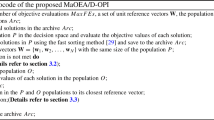Abstract
Multi-objective optimization is an inseparable area of optimization and plays a crucial role in terms of practicality. Almost all multi-objective optimization problems in the real world are suitable as opposed to goals with several ideal models around. Rather than one optimal solution, these issues have a set of optimal solutions known as the Pareto optimal solution. Owing to the lack of proper optimal methodology for finding effective optimal solutions, classical solutions to these problems were changed from multi-objective ones to a single-objective solution. They usually need to perform repetitive applications of an algorithm to find the Pareto optimal solutions. In some cases, such programs cannot even guarantee the Pareto optimal solution. In contrast, the population-oriented approach of Evolutionary Algorithms (EAs) is an effective way to find multiple Pareto optimal solutions in a single program simultaneously. In this research, a multi-objective optimal evolutionary algorithm is represented based on the educational system, which is compared with other multi-objective optimal algorithms.







Similar content being viewed by others
References
Zhou A, Qu B -Y, Li H, Zhao S -Z, Suganthan P N, Zhang Q (2011) Multiobjective evolutionary algorithms: a survey of the state of the art. Swarm Evol Comput 1:32–49
Deb K (2014) Multi-objective optimization. In: Search methodologies. Springer, pp 403–449
Vachhani V L, Dabhi V K, Prajapati H B (2015) Survey of multi objective evolutionary algorithms. In: 2015 International conference on circuit, power and computing technologies (ICCPCT), pp 1–9
Fonseca C M, Fleming P J (1993) Multiobjective genetic algorithms. In: IEE Colloquium on genetic algorithms for control systems engineering, pp 6/1–6/5
Srinivas N, Deb K (1994) Muiltiobjective optimization using non-dominated sorting in genetic algorithms. Evol Comput 2:221–248
Horn J, Nafpliotis N, Goldberg D E (1994) A niched Pareto genetic algorithm for multiobjective optimization. In: Proceedings of the first IEEE conference on evolutionary computation. IEEE World congress on computational intelligence, pp 82–87
Deb K, Pratap A, Agarwal S, Meyarivan T (2002) A fast and elitist multiobjective genetic algorithm: NSGA-II. IEEE Trans Evol Comput 6:182–197
Zitzler E, Thiele L (1999) Multiobjective evolutionary algorithms: a comparative case study and the strength Pareto approach. IEEE Trans Evol Comput 3:257–271
Zitzler E, Laumanns M, Thiele L, Zitzler E, Zitzler E, Thiele L, Thiele L (2001) SPEA2: improving the strength Pareto evolutionary algorithm. Eidgenössische Technische Hochschule Zürich (ETH) Institut für Technische Informatik und Kommunikationsnetze (TIK)
Knowles J D, Corne D W (2000) Approximating the non-dominated front using the Pareto archived evolution strategy. Evol Comput 8:149–172
Corne D W, Knowles J D, Oates M J (2000) The Pareto envelope-based selection algorithm for multiobjective optimization. In: Parallel problem solving from nature PPSN VI, pp 839–848
Corne D W, Jerram N R, Knowles J D, Oates M J (2001) PESA-II: region-based selection in evolutionary multiobjective optimization. In: Proceedings of the genetic and evolutionary computation conference GECCO’2001
Coello C A C, Pulido G T, Lechuga M S (2004) Handling multiple objectives with particle swarm optimization. IEEE Trans Evol Comput 8:256–279
Zhang Q, Li H (2007) MOEA/D: a multiobjective evolutionary algorithm based on decomposition. IEEE Trans Evol Comput 11:712–731
Li H, Zhang Q (2009) Multiobjective optimization problems with complicated Pareto sets, MOEA/D and NSGA-II. IEEE Trans Evol Comput 13:284–302
Nandasana A D, Ray A K, Gupta S K (2003) Applications of the non-dominated sorting genetic algorithm (NSGA) in chemical reaction engineering. Int J Chem Reactor Eng, vol 1, p No pp given
Saini A, Saraswat A (2012) Solving amulti-objective reactive power market clearing model using NSGA-II. Int J Adv Inf Technol (IJAIT) 2:49–60
Deb K, Jain S (2002) Running performance metrics for evolutionary multi-objective optimizations. In: Proceedings of the Fourth Asia-Pacific conference on simulated evolution and learning (SEAL’02). Singapore, pp 13–20
Zitzler E, Deb K, Thiele L (2000) Comparison of multiobjective evolutionary algorithms: empirical results. Evol Comput 8:173–195
Deb K, Pratap A, Agarwal S, Meyarivan T (2002) A fast and elitist multiobjective genetic algorithm: NSGA-II. IEEE Trans Evol Comput 6:182–197
Mirjalili S (2016) Dragonfly algorithm: a new meta-heuristic optimization technique for solving single-objective, discrete, and multi-objective problems. Neural Comput Applic 27:1053–1073
Atashpaz-Gargari E, Lucas C (2007) Imperialist competitive algorithm: an algorithm for optimization inspired by imperialistic competition. In: IEEE Congress on evolutionary computation, 2007. CEC 2007, pp 4661–4667
Singh M, Panigrahi B, Abhyankar A (2013) Optimal coordination of directional over-current relays using teaching learning-based optimization (TLBO) algorithm. Int J Electric Power Energy Syst 50:33–41
Author information
Authors and Affiliations
Corresponding authors
Rights and permissions
About this article
Cite this article
Moradi, H., Ebrahimpour-Komleh, H. Development of a multi-objective optimization evolutionary algorithm based on educational systems. Appl Intell 48, 2954–2966 (2018). https://doi.org/10.1007/s10489-017-1122-x
Published:
Issue Date:
DOI: https://doi.org/10.1007/s10489-017-1122-x




